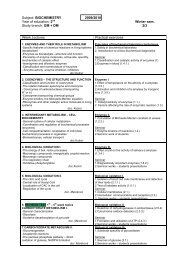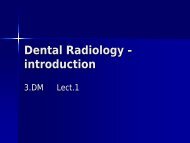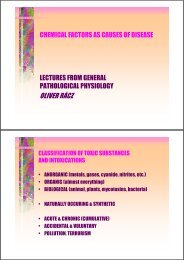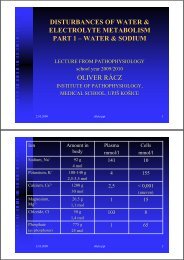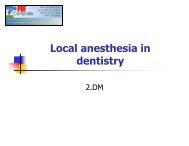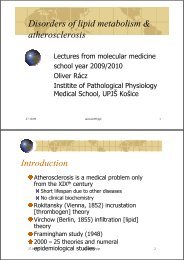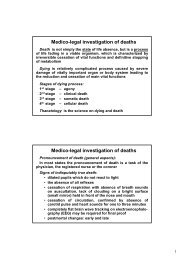ventilation - TOP Recommended Websites
ventilation - TOP Recommended Websites
ventilation - TOP Recommended Websites
Create successful ePaper yourself
Turn your PDF publications into a flip-book with our unique Google optimized e-Paper software.
OXYGEN THERAPY<br />
& ARTIFICIAL<br />
VENTILATION<br />
Department of<br />
Anaesthesiology & Intensive Medicine<br />
Šafárik University Faculty of Medicine, Košice<br />
MUDr. Jozef Firment, PhD.<br />
1
REASONS OF HYPOXEMIA<br />
IN POS<strong>TOP</strong>ERATIVE PERIOD<br />
• FiO 2 decrease?<br />
• V/Q disturbances – the most frequent<br />
• Lung shunts – secretions, atelectases<br />
• Hypo<strong>ventilation</strong> – anesthesia efects<br />
• Difussion disturbances – interstitial lung<br />
oedema<br />
• Hypoxia from difusion N 2 O 40 x > N 2<br />
2
PREDISPOSITION FACTORS<br />
FOR RETENTION OF SECRETIONS<br />
• Surgery site (thoracic, epigastrium ><br />
hypogastrium)<br />
• Preexist respiratory disease (infection,<br />
hypersecretion)<br />
• Smoking<br />
• Obesity (FRC, WOB)<br />
3
BRONCHIAL SECRETIONS<br />
RETENTION IN POS<strong>TOP</strong>ERATIVE<br />
PERIOD<br />
• Expectoration insufficiency (painful wound,<br />
sedation, muscle weakness K + , P)<br />
• bronchial ciliary activity (dry inspir. gases,<br />
anesthetics)<br />
• Antisialogic medicaments (premedication)<br />
• Infection (washing mechanisms failure)<br />
= atelectases, WOB, hypoxemia,<br />
global respir. insuficiency<br />
4
CONSEQUENCES OF<br />
SECRETION RETENTION<br />
• Atelectasis:<br />
during 24 h post surgery, fever 38-39 o C,<br />
tachycardia, tachypnoe, cough, cyanosis?, x-<br />
ray - spot obscuration<br />
• Bronchopneumonia:<br />
Unusual lobar, elder pats., slower onset than<br />
in atelectatic cause, fever, tachypnoe, x-ray –<br />
more dense obscuration, especially basally<br />
5
Duggan M., Kavanagh BP: Pulmonary Atelectasis. A Pathogenic Perioperative Entity.<br />
Anesthesiology 2005; 102:838–54<br />
6
Duggan M., Kavanagh BP: Pulmonary<br />
Atelectasis. A Pathogenic Perioperative<br />
Entity. Anesthesiology 2005; 102:838–54<br />
7
LABORATORY<br />
INVESTIGATIONS<br />
• p a O 2 , p c O 2 , p v O 2 (ABR + pO 2 )<br />
• possible mistakes and artefacts<br />
steady state, taking of blood samples,<br />
storage, laboratory<br />
8
CHANGES OF FRC AND PaO 2<br />
IN POS<strong>TOP</strong>ERATIVE TIME<br />
9
POOS<strong>TOP</strong>ERATIVE<br />
PNEUMONIA TREATMENT<br />
• ATB according to sputum cultivation<br />
• Oxygen FiO 2 0,3-0,4 according to ABB<br />
• Artif. ventilat., non-responders to O 2 and<br />
activation of auxiliary respiratory<br />
muscles, p a O 2 , p a CO 2<br />
10
Aitkenhead<br />
GAS<br />
EXCHANGE<br />
DURING<br />
HYPO-<br />
VENTILATION<br />
11
12<br />
WEST‘S LUNG ZONES<br />
Soni-OHMEDA Firment
VENTILATORY MECHANICS<br />
SPONTANEOUS BREATHING<br />
zone > <strong>ventilation</strong><br />
zone > perfusion<br />
ARTIFICIAL BREATHING<br />
ATELECTASES<br />
Evita 2 dura Dräger 1999<br />
13
SITUATIONS FOR LONGER OXYGEN<br />
THERAPY DURING<br />
POS<strong>TOP</strong>ERATIVE PERIOD<br />
• Hypotension<br />
• IHD<br />
• C.O.<br />
• Anaemia<br />
• Obesity<br />
• Shivering<br />
• Hypothermia<br />
• Hyperthermia<br />
• Lung oedema<br />
• Airway<br />
obstruction<br />
• After large<br />
procedures<br />
14
OXYGEN CASCADE<br />
15
OXYGEN THERAPY<br />
• Every pt. 10 min after general<br />
anaesthesia should obtain 100% oxygen<br />
• Cave:<br />
Recovery room<br />
Postoperative dpt., ICU...<br />
16
HYPERBAROXIA<br />
http://www.hyperbarickecentrum.sk/podstata.html<br />
17
HYPERBAROXIA<br />
1. Air or Gas Embolism<br />
2. Carbon Monoxide Poisoning<br />
3. Clostridal Myositis and Myonecrosis (Gas Gangrene)<br />
4. Crush Injury, Compartment Sy, & Acute Traumatic Ischemias<br />
5. Decompression Sickness<br />
6. Enhancement of Healing in Selected Problem Wounds<br />
7. Exceptional Blood Loss (Anemia)<br />
8. Intracranial Abscess<br />
9. Necrotizing Soft Tissue Infections<br />
10. Osteomyelitis (Refractory)<br />
11. Delayed Radiation Injury (Soft Tissue and Bony Necrosis)<br />
12. Skin Grafts & Flaps (Compromised)<br />
13. Thermal Burns<br />
http://www.uhms.org/Indications/indications.htm,<br />
http://www.oxynet.org/<br />
18
EQUIPMENT FOR OXYGEN<br />
THERAPY<br />
Spont inspiration - Peak Inspiratory Flow = 20 - 30 l/min<br />
• Nasal sonds<br />
• Oxygen „eye-glasses“<br />
• Face mask<br />
• Venturi mask 4l 28%, 8l 40%, 15l 60%)<br />
• CPAP 10 cmH 2 0<br />
• Artifitial <strong>ventilation</strong><br />
19
Campbell<br />
VENTI MASK<br />
20
Campbell<br />
O 2 FiO 2 V T x f<br />
l/min %<br />
adult: 13 85-100 1000 x 15<br />
- “ - 4 >40 dtto<br />
child 5 85-100 300 x 20<br />
- “ - 2 >40 dtto<br />
SELF-EXPANDING BAG<br />
WITH O 2<br />
Inflow O 2<br />
10 - 13 l/min<br />
21
NECESSITY OF FiO 2 CONTROL<br />
• Normaly inspiratory force is regulated<br />
by PaCO 2 level (5,3 kPa)<br />
• Patients regulated insiratory force by<br />
paO 2 (chronic bronchitis), 1-2 l/min O 2 , ,<br />
28% O 2<br />
• ARDS: paO 2 /FiO 2 = shunt amount<br />
22
norma = 3 - 8%<br />
TO OXYGEN ADMINISTRATION<br />
13,3<br />
RESPONSE PaO 2<br />
23
POSITION OF A. & V.<br />
POINTS IN VARIOUS pH<br />
Aitkenhead<br />
24
POSITION OF A. & V. POINTS<br />
(PAT’S WITH CHRON. RESPIR. DISEASE)<br />
Regulation of inspiratory<br />
force by PaO 2 decrease<br />
In higher FiO 2 threat<br />
respiratory depresion<br />
25
BYPASS OF NASAL CAVITY<br />
Water vapour content r.h. 100% in 37 o C = 44 mg/l<br />
V = 10 l/min 0,4 ml H 2 O/min, i.e. 24 ml H 2 O/hod<br />
600 ml/24 hod<br />
+ hyper<strong>ventilation</strong> !<br />
+ fever !<br />
Inspiration of dry air =<br />
= losses 700-1000 ml/day<br />
Aim: humidification to 100% r.h.<br />
warming<br />
37 o C<br />
26
CONSEQUENCES OF INSUFFICIENT<br />
HUMIDIFICATION OF INSPIRATORY<br />
GASES<br />
• Losses of clear water from airway<br />
• Concentration of secretions in airway<br />
– failureof mucociliary transport<br />
– airway obstruction<br />
– development of atelektases<br />
– airway infection<br />
27
AIMS OF VENTILATORY<br />
SUPPORT<br />
• Bypassing of critical time during illness.<br />
• Achievement of acceptible oxygenation<br />
and <strong>ventilation</strong> paremeters.<br />
• Elimination of side effects of artifitial<br />
<strong>ventilation</strong>.<br />
28
PHYSIOLOGICAL AIMS<br />
1. Alveolar <strong>ventilation</strong>, paCO 2 , pH,<br />
2. Oxygention support, paO 2 above 8 kPa,<br />
SaO 2 above 90%, CaO 2 . Transport blood<br />
capacity for oxygen (HB x SaO 2 x C.O.)<br />
3. Increase of lung volume (FRC) - PEEP<br />
(against athelectases, improving of<br />
oxygenation, ARDS, postoperative cases)<br />
4. Decreasing work of respiratory muscles.<br />
29
CLINICAL AIMS<br />
1. Treatment and reverse of hypoxaemia<br />
2. Treatment of acute respiratory acidosis<br />
3. Solution od respiratory distress<br />
4. Prophylaxy and treatment of atelectases<br />
5. Help for respiratopry muscle weakness<br />
6. Permision of pts. sedation / relaxtion<br />
7. Systemic and / or myocardial decreasing of<br />
oxygen consumption (cardiogenic shock,<br />
ARDS)<br />
8. Decreasing of ICP through paCO 2 .<br />
9. Thoracic wall stabilisation (flail chest)<br />
30
INDICATIONS FOR<br />
ARTIFICIAL VENTILATION<br />
• Mechanics: f above 35/min, VC below 15<br />
ml/kg, Insp.neg pressure below 25 cmH 2 0.<br />
• Oxygenation: paO 2 below 70 mmHg at FiO 2<br />
0,4 by mask, AaDO 2 above 350 mmHg at<br />
FiO 2 1,0 or Qs/Qt above 20% (paO 2 /FiO 2<br />
below 200)<br />
• Ventilation: Apnoe, paCO 2 above 55 mmHg<br />
(except pat with chron. hyperkapnia), Vd/Vt<br />
above 0,60.<br />
• Crucial are clinical findings!<br />
31
PHYSIOLOGICAL AND<br />
PATHOPHYSIOLOGICAL PRINCIPLES<br />
OF ARTIFITIAL VENTILATION<br />
• Airway securing during <strong>ventilation</strong><br />
• Apparatuses and equipment used<br />
during <strong>ventilation</strong><br />
• Tactics of <strong>ventilation</strong>, ventilatory modes<br />
• Monitoring of <strong>ventilation</strong><br />
• Complications of <strong>ventilation</strong><br />
• Weaning from ventilator<br />
32
SOME PARAMETERS USED AS<br />
INDICATORS OF ARTIFICIAL<br />
Parameter<br />
VENTILATION<br />
Physiologic<br />
al values<br />
Indications<br />
for artificial<br />
support<br />
Vital capacity (ml/kg)<br />
V D<br />
/V T<br />
Inspiratory force (cmH 2<br />
O)<br />
Lung shunt (%) (Q s<br />
/Q t<br />
)<br />
paO 2<br />
(kPa) (at FiO 2<br />
= 0,21)<br />
p(A – a)DO 2<br />
(kPa) (at FiO 2<br />
= 0,21)<br />
paO 2<br />
/FiO 2<br />
(kPa)<br />
paO 2<br />
/FiO 2<br />
(mmHg)<br />
paCO 2<br />
(kPa)<br />
pH<br />
Respiratory frequency<br />
60 – 70<br />
0,3<br />
– (80 – 100)<br />
5<br />
13<br />
1,3 – 4<br />
> 40<br />
> 300<br />
5,3<br />
7,35 – 7,45<br />
12 – 18<br />
10 – 15<br />
0,6<br />
< – 20<br />
> 15<br />
< 6,6<br />
> 350<br />
< 40<br />
< 300<br />
7,3 – 8<br />
< 7,25<br />
> 35 – 40<br />
33
AYRE T-PIECE<br />
Inlet O 2<br />
FGF < 2 x MV<br />
22 mm (20 cm 80ml)<br />
Atmosphere<br />
22/15 mm<br />
Face mask Tube - orotracheal<br />
- nasotracheal<br />
- tracheostomy<br />
35
(S)CMV, Assist Control<br />
• I:E Peak Flow %Ti<br />
• Pause (%) Tip (s) from total respir. cycle<br />
36
37<br />
Oh - Firment
BLOOD GASES INFLUENCE BY<br />
ARTIFICIAL VENTILATION<br />
p a CO 2<br />
• alveolar<br />
<strong>ventilation</strong><br />
(VT, f, P insp ...)<br />
• FiO 2<br />
p a O 2<br />
• mean P aw<br />
(PEEP,<br />
I:E Peak Flow %Ti,<br />
Pause (%) Tip (s) )<br />
38




